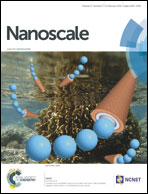Summary: A systematic study on the use of 9,9-dialkylfluorene homopolymers (PFs) for large-diameter semiconducting (sc-) single-walled carbon nanotube (SWCNT) enrichment is the focus of this report. The enrichment is based on a simple three-step extraction process: (1) dispersion of as-produced SWCNTs in a PF solution; (2) centrifugation at a low speed to separate the enriched sc-tubes; (3) filtration to collect the enriched sc-SWCNTs and remove excess polymer. The effect of the extraction conditions on the purity and yield including molecular weight and alkyl side-chain length of the polymers, SWCNT concentration, and polymer/SWCNT ratio have been examined. It was observed that PFs with alkyl chain lengths of C10, C12, C14, and C18, all have an excellent capability to enrich laser-ablation sc-SWCNTs when their molecular weight is larger than 10 000 Da. More detailed studies were therefore carried out with the C12 polymer, poly(9,9-di-n-dodecylfluorene), PFDD. It was found that a high polymer/SWCNT ratio leads to an enhanced yield but a reduced sc-purity. A ratio of 0.5–1.0 gives an excellent sc-purity and a yield of 5–10% in a single extraction as assessed by UV-vis-NIR absorption spectra. The yield can also be promoted by multiple extractions while maintaining high sc-purity. Mechanistic experiments involving time-lapse dispersion studies reveal that m-SWCNTs have a lower propensity to be dispersed, yielding a sc-SWCNT enriched material in the supernatant. Dispersion stability studies with partially enriched sc-SWCNT material further reveal that m-SWCNTs : PFDD complexes will re-aggregate faster than sc-SWCNTs : PFDD complexes, providing further sc-SWCNT enrichment. This result confirms that the enrichment was due to the much tighter bundles in raw materials and the more rapid bundling in dispersion of the m-SWCNTs. The sc-purity is also confirmed by Raman spectroscopy and photoluminescence excitation (PLE) mapping. The latter shows that the enriched sc-SWCNT sample has a narrow chirality and diameter distribution dominated by the (10,9) species with d= 1.29 nm. The enriched sc-SWCNTs allow a simple drop-casting method to form a dense nanotube network on SiO2/Si substrates, leading to thin film transistors (TFTs) with an average mobility of 27 cm2 V−1 s−1 and an average on/off current ratio of 1.8 × 106 when considering all 25 devices having 25 μm channel length prepared on a single chip. The results presented herein demonstrate how an easily scalable technique provides large-diameter sc-SWCNTs with high purity, further enabling the best TFT performance reported to date for conjugated polymer enriched sc-SWCNTs.
Enrichment of large-diameter semiconducting SWCNTs by polyfluorene extraction for high network density thin film transistors
